Hello FACNM community!
We hope you’re all having a great week so far. In honor of New Mexico’s vibrant art community we wanted to use this Wildfire Wednesday to talk about the role wildfire plays in the arts. There are many relationships between art and wildfire: Wildfire can serve as a source of inspiration or provide a medium for art, the effects of wildfire can be communicated through art, and art can increase situational awareness or understanding of wildfire. Keep reading to learn more about how artists are being influenced by or incorporating wildfire into their artwork.
This Wildfire Wednesday features information on:
Fire journaling (Pyrosketchology)
Wildfire as a medium
The Fires of Change project
Save the Date! March 2022 Cross-Boundary Landscape Restoration Workshop
Stay healthy!
Liz
Fire Journaling
Fire journaling, or pyrosketchology, is a “technique developed by Miriam Morrill to marry the study of fire with journaling and illustration.” This process is being used by artists and community members to document ecological changes on a landscape after fire, increase observational skills and awareness of fire risk, communicate fire science, and more. Click on some of the links below to read more about how artists, scientists, and citizens alike are using fire journaling.
Miriam Morrill
Miriam Morrill, a former Bureau of Land Management employee, has been leading workshops to introduce pyrosketchology to fire professionals. Pyrosketchology has the potential to improve situational awareness for firefighters, improve evacuation planning, track ecological changes and risk, and expand peoples’ perceptions of the natural world.
There are two articles of interest focusing on Miriam Morrill’s experiences with pyrosketchology:
Click here to read the Sierra Club’s article
Click here to read the Fire Adapted Communities Learning Network article
One of Robin Carlson’s many illustrations from her post-wildfire sketchbook
Robin Carlson
Robin Carlson is a “local natural science illustrator with a particular interest in following changes in landscapes and ecological communities over time.” Through Steebins Cold Canyon Fire Recovery sketchbook, Robin captures the response and recovery of landscapes post-wildfire.
Click here to learn more about Robin Carlson’s Steebins Cold Canyon Fire Recovery sketchbook
Wildfire as a Medium
While it’s difficult for many to see past the devastation after a wildfire, some artists have managed to find beauty and incorporate the remnants of fire in their artwork.
Laurie Wigham
After the fire
Artist Laurie Wigham used charred sticks from the aftermath of a wildfire in the Sierra Nevada to create watercolor, ink and charcoal paintings of the post-wildfire landscape. Click here to see more of her watercolor paintings of the aftermath of recent forest fires in the Sierra Nevada.
Ashes to Art
Credit: Tim O’Hara
This project shipped charcoal salvaged from the 2012 High Park Fire and the 2020 Cameron Peak Fire to artists all over the country to be integrated into their art projects in an effort to raise money for the local fire departments. Artists used the charcoal in drawings, pottery, knife handles, etched bowls, and more. Read more about this project on the KUNC website here.
Fires of Change
In 2014, 11 artists participated in a project “designed to integrate fire and climate science with art to offer a unique interpretation for the northern Arizona community... the artists attended field trips to the North Rim of the Grand Canyon and other locations in northern Arizona with fire managers and scientists to learn about fire and climate science” (SWFSC). Following the field trips, art exhibitions featuring the resulting pieces ran in 2015 and 2016. Click here to see a slideshow of the pieces created for this project.
Visitor surveys from the exhibits showed that the Fires of Change exhibit “increased visitors’ understanding of the effect of climate change on fire regimes and increased visitors’ support for management actions to address the effects of climate change on fire behavior.” This demonstrates that art can be a powerful tool for communicating issues around wildfire. Click here to read the paper on this study from the journal of Fire Ecology.





